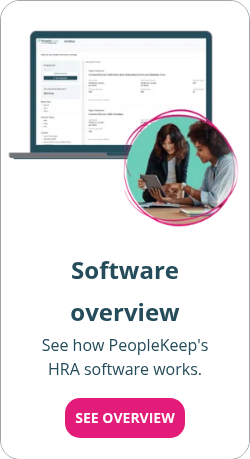ICHRA administration for first-timers
By Elizabeth Walker on February 10, 2025 at 9:00 AM
Offering an individual coverage health reimbursement arrangement (ICHRA) is an effective way for employers to attract and support talented workers. With an ICHRA, organizations can reimburse employees tax-free for their individual health insurance premiums and other qualified out-of-pocket medical expenses.
If you’re considering an ICHRA at your company, you must know how to administer it. Whether offering an ICHRA as a stand-alone benefit or for your employee classes that don’t qualify for your traditional group plan, setting up and administering a compliant ICHRA on your own can be challenging.
In this blog post, you’ll learn:
- How to create a compliant ICHRA plan that meets ERISA and other federal regulations.
- Employee notification and administration best practices
- The costs and challenges of self-administering an ICHRA
Create a legal plan document
The federal government considers an ICHRA a group health plan. That makes it subject to Employee Retirement Income Security Act (ERISA) requirements. The first of these requirements is drafting a legal plan document outlining the details of your ICHRA plan.
No specific penalties apply for failing to prepare and adopt a plan document. Still, you’ll be subject to fines if plan participants request to see your document and you don’t produce it.
Your document must include these items to comply with ERISA standards:
- A list of named fiduciaries and plan administrators and their responsibilities
- A description of how you fund the ICHRA
- Your ICHRA’s reimbursement rules
- Information on federal regulations, such as the Affordable Care Act’s employer mandate if you’re an applicable large employer (ALE)
- The procedure for amending the plan
ERISA doesn’t require these items. But we recommend them so you can provide a more useful document to employees:
- Eligibility requirements for the ICHRA, such as defining employee classes
- Effective dates of participation
- A description of benefits the ICHRA provides and excludes, such as eligible expenses
- Medical claims procedures
- HIPAA privacy officers and rules relating to the use of protected health information (PHI)
- The process for plan termination
Notify your employees about the ICHRA
Before the ICHRA’s start date, the plan administrator should notify each class of employees of their eligibility at least 90 days before the plan year begins. You also must provide the notice every year you offer the ICHRA.
“Newly eligible workers” to the benefit are newly hired employees or employees who gain eligibility after the plan year's initial start. Your organization can provide notice to this group up until the first business day the employee’s ICHRA coverage begins.
It’s best to provide notice as soon as possible so employees can review their policy options and enroll in individual health coverage.
The notice must include the following to comply with federal regulations:
- A description of the terms of the ICHRA, including your employer contribution amounts
- A statement of the participant’s right to opt out of the benefit and waive future reimbursement under the ICHRA
- A statement on how the ICHRA will affect premium tax credit (PTC) eligibility. Include information on what happens if the employee opts out or chooses to accept the benefit
- A statement that the participant must inform any health exchange to which they apply for advanced premium tax credits of certain relevant information
- A statement about how the ICHRA differs from other HRAs
- A statement about how the participant can find assistance for determining ICHRA affordability based on the lowest-cost silver plan in their area
- A statement explaining how the ICHRA can integrate with Medicare
- Contact information for the individual or a group of individuals participants can reach out to with questions regarding their ICHRA
- A statement explaining an ICHRA’s substantiation process and attestation
Another critical message to communicate to your employees is the enrollment guidelines for the ICHRA based on timing.
Let’s look at some timeline examples below:
|
The ICHRA starts on a date other than January 1, or a newly hired employee joins the benefit mid-plan year |
An employee becomes eligible for an ICHRA that would start at the beginning of the plan year |
An employee becomes eligible for ICHRA coverage that starts mid-year (such as an employee with a reduction of work hours) |
|
They can use a 60-day special enrollment period to enroll in individual health insurance coverage outside of Open Enrollment. |
They must enroll in an individual coverage plan within the 60-day period before the first day of the plan year. |
They can enroll in an individual plan up to 60 days before the first day that their ICHRA begins. They can also enroll in coverage up to 60 days after this date if they weren’t provided at least 60 days of notice. |
Establish compliant administration procedures
Once you’ve created legal plan documents and notified your eligible employees, you can start administering it.
Remember, administering an ICHRA differs from administering a traditional group health insurance plan. There’s no insurance company to handle most of the responsibilities. Instead, you must manage the plan yourself, which can take substantial time. But, you can use an HRA administration platform to make the process easier.
1. Updating your plan with staff changes
You must appropriately extend or end ICHRA eligibility when you gain or lose employees.
Here are the rules:
- If you hire a new employee, you must give them their federally required notice and extend eligibility according to your plan documents.
- You must also take any waiting periods into account. For example, suppose you set a waiting period of 60 days for new hires. In that case, you must extend employee eligibility to the ICHRA after those 60 days of employment.
- If you lose an employee through termination or voluntary departure, you must handle any outstanding reimbursement requests and end eligibility according to your plan documents.
- Employees must receive payment for all approved reimbursement requests until they leave your organization. Any remaining employer contributions stay with you.
You don’t need to update the plan documents when gaining or losing employees unless the employee manages your ICHRA benefit.
If you have 20 or more employees, your ICHRA is subject to the federal Consolidated Omnibus Budget Reconciliation Act (COBRA). Depending on your state, your benefit may be subject to state COBRA laws even if you have fewer than 20 employees. In these cases, organizations must provide all covered individuals with the option to elect COBRA coverage to continue to access their ICHRA.
2. Receiving and processing reimbursement requests
When your employees make a reimbursement claim for their individual insurance premiums or other qualified out-of-pocket expenses, they must provide you with adequate proof.
The documentation, such as a receipt or invoice, must include the following:
- The service or product
- The date of the service or sale
- The amount incurred
Employees only submit some recurring eligible expenses, like a monthly premium, once. This applies as long as the recurring reimbursement request matches previous reimbursements you approved with the same amount, service provider, and date. Employees can find this information for individual health plans in their explanation of benefits (EOB).
Your organization must review your employees’ submissions and approve or decline the reimbursement request.
You’ll check to see if the documentation includes:
- A qualified medical expense under IRS Code Section 213(d)1
- The service or product
- The date of the service or sale and the amount incurred.
If everything’s in order, you’ll approve the request and reimburse the employee from their available allowance. If not, you’ll decline it and follow the process for adverse claims decisions outlined in your plan documents.
This involves having a good grasp of IRS rules. Otherwise, you could risk your ICHRA becoming noncompliant. You can work with an HRA administration platform like PeopleKeep to take this task off your plate.
3. Handling declined reimbursement requests and appeals
To be ERISA compliant, your organization must have a specific procedure for declining reimbursement requests and appeals.
Here are the timelines:
- If you’re declining one of your employee’s reimbursement requests, you must notify them within 30 days of receiving their request.
- If you declined the request because your employee didn’t provide enough information, they have 45 days from the date you notified them to get the missing information.
You can approve the reimbursement request if the new information has everything you need. If not, your employee can appeal the declined request under ERISA. During the appeals process, you must follow regulations issued by ERISA and the Department of Labor and the procedures outlined in your plan documents.
You can proceed with the reimbursement request if the result favors the employee.
4. Paying reimbursements
Once you’ve approved an employee’s reimbursement request, you must pay it according to the timeline and processes outlined in your plan documents.
Employees must have a qualifying form of individual health insurance that provides minimum essential coverage (MEC) to participate in an ICHRA. Any employee reimbursements for qualifying medical expenses are tax-free for you and your employees.
If an employee loses qualifying coverage during the plan year, they can’t participate in the ICHRA until they enroll in coverage again.
When processing reimbursements to employees, you can use the following:
- Payroll
- Direct deposit
- Check
- Cash
Suppose the reimbursement request was more than the employee’s accrued allowance. In that case, you should pay the employee the total amount of their accumulated allowance. Then, you can continue to make monthly payments toward the balance until it’s paid in full or the employee’s annual maximum allowance is gone.
5. Recordkeeping and storing documentation
The federal government has guidelines for organizations contributing to employees’ IRS-qualified medical expenses, including through an ICHRA.
Your organization must keep an ongoing record of your ICHRA payments and substantiation. This should include the allowance, all reimbursement requests, the supporting documentation, and whether you approved or declined those requests.
The IRS has a statute of limitations of seven years, so it’s best practice to store this information for at least that long.
6. Keeping PHI safe
Whether your organization must comply with HIPAA standards or not, the plan sponsor must certify that employees’ PHI is safe and not used for employment-related actions. For example, initiating any action against employees who receive medical care or medications you may disagree with is illegal.
If you have a HIPAA privacy officer, only this individual should see this information. You can track and store this information using spreadsheets or other administration software. But be mindful of your employees’ privacy and standard security procedures.
7. Evaluating allowance amounts
As part of your organization’s annual budget review, you may want to revisit the monthly allowances you give employees through your ICHRA.
If you need to lower your monthly allowance for cost control or you’d like to increase your benefit’s value by raising it, let your employees know before the start of the plan year through the required notice.
8. Fulfilling tax reporting requirements
As previously mentioned, ICHRA health coverage provides tax advantages for you and your employees because reimbursements are tax-free. So, there are mandatory reporting requirements you must follow.
Employees are responsible for tracking any reimbursements they accidentally made for incurred expenses while they didn’t have MEC. They will need to include these amounts in their gross taxable income or pay you back for those reimbursements.
Organizations that offer an ICHRA must also complete Form 1095 each year. This is how you’ll report your ICHRA benefit to the federal government.
Need more specific reporting information for your ICHRA? Read our blog.
Consider the costs of self-administering your ICHRA
Before you try to self-administer your ICHRA, it’s essential to understand the hidden costs of this approach.
Here’s a look at the potential costs:
- A noncompliant ICHRA can subject your organization to the excise tax outlined in IRC Section 4980(d)2.
- The Departments of the Treasury, Health and Human Services, and Labor could charge your organization up to $100 per employee per day for violating the market reforms3.
- Many small business owners contract with an attorney to draft the plan document to avoid that risk.
- Contract drafting costs range between $200 and $800 for a simple contract and $1,000 and $5,000 for a complex document4.
- The cost of your time spent reviewing employees’ reimbursements, submitting payments, and sending out annual ICHRA notices is also significant.
- An average HR representative’s annual salary is roughly $61,000. Dedicating just 400 hours per year—or 7 hours a week—to ICHRA administration tasks could be almost $11,000 annually5.
Between plan document fees, potential compliance penalties, and the time cost, administering your ICHRA on your own may not be the bargain you think.
Want help administering your ICHRA?
If you like the freedom that comes with self-administration but want to save money and avoid potential compliance pitfalls, administering an ICHRA using PeopleKeep’s HRA software is a perfect match.
Here are the perks of using our HRA software:
- Most customers only need about 15 minutes per month to administer their benefits, which is significantly less time than managing a group health insurance plan.
- Our software solution has several key features that help you create and manage your ICHRA:
- Assistance in designing an IRS-compliant employee benefit
- Automation of the creation of legal plan documents
- Verification of employee expenses for reimbursement for your approval
- Automatic sending of required notices
- An integrated shopping platform so employees can shop for health insurance and ancillary coverage right from their accounts
- We handle the most time-consuming tasks, such as:
- Preparing and updating legal documents
- Reviewing reimbursement requests
- Sending weekly email reports with any reimbursements you need to approve.
Here’s the best part—unlike working with third-party administrators, you aren’t giving up control of your benefit. Our software and award-winning customer support team are here to help you.
Conclusion
An ICHRA is a modern and flexible solution that can support all your employees’ medical needs. However, you must manage it correctly for the benefit to provide value. Self-administering an ICHRA is tempting, but it's unrealistic for most small and mid-size employers. While it may be the right option for some, the time-consuming compliance considerations of self-administration make many employers avoid it.
If you prefer the independence of self-administration but want help, an HRA software solution with plan design flexibility, like PeopleKeep, is an excellent choice. Contact our HRA specialists, and we’ll ease your administrative burden.
This article was originally published on March 1, 2021. It was last updated on February 10, 2025.
3. Health insurance market reforms
Check out more resources
See these related articles

What to expect when your employer offers you an ICHRA
Curious about ICHRAs? Discover what to expect when your employer offers you an individual coverage health reimbursement arrangement with this guide.

How HRAs work for spouses and dependents
Learn about the eligibility and benefits of health reimbursement arrangements (HRAs) for spouses and dependents in this comprehensive overview.

How to calculate FTEs to determine ALE status
Learn what a full-time equivalent employee (FTE) is, what your FTE number means if you’re an ALE, and how to calculate how many FTEs you employ.



